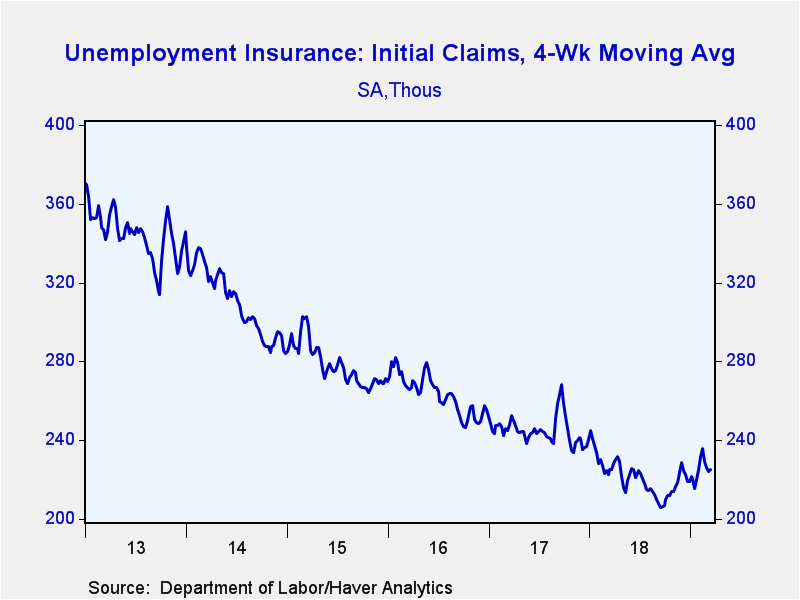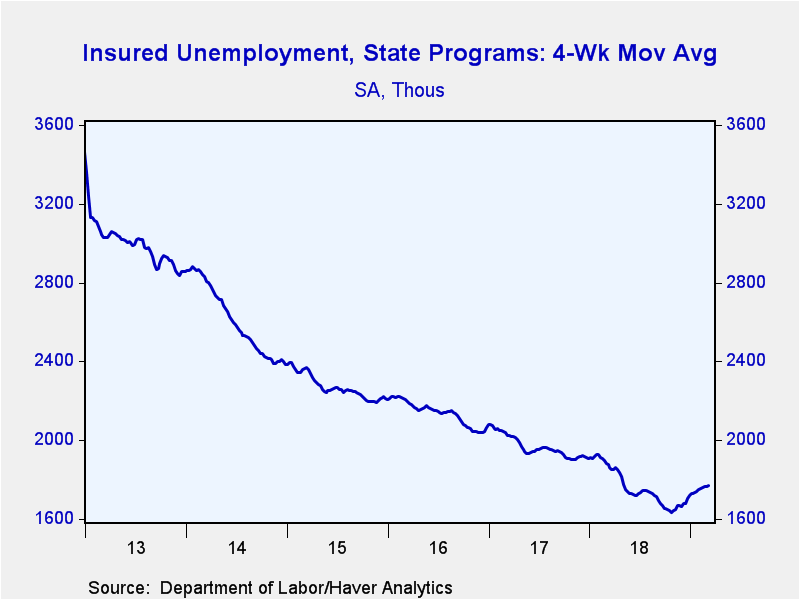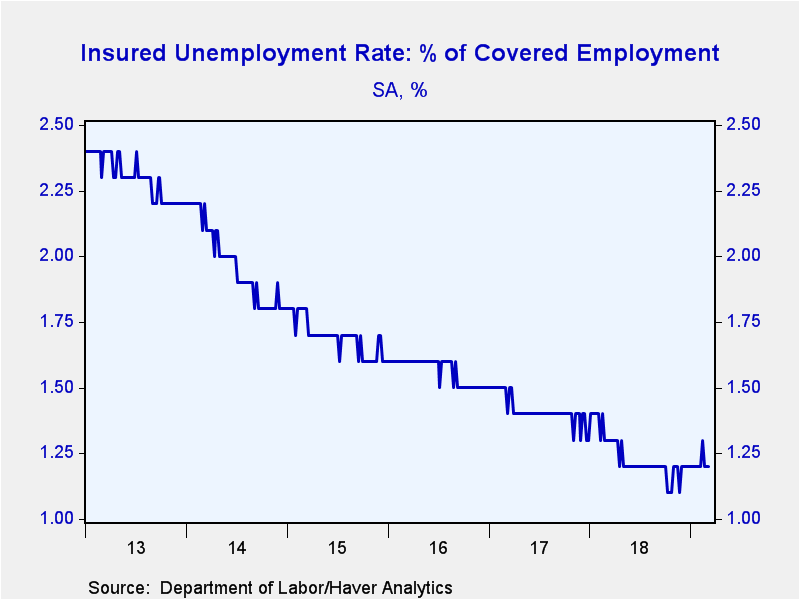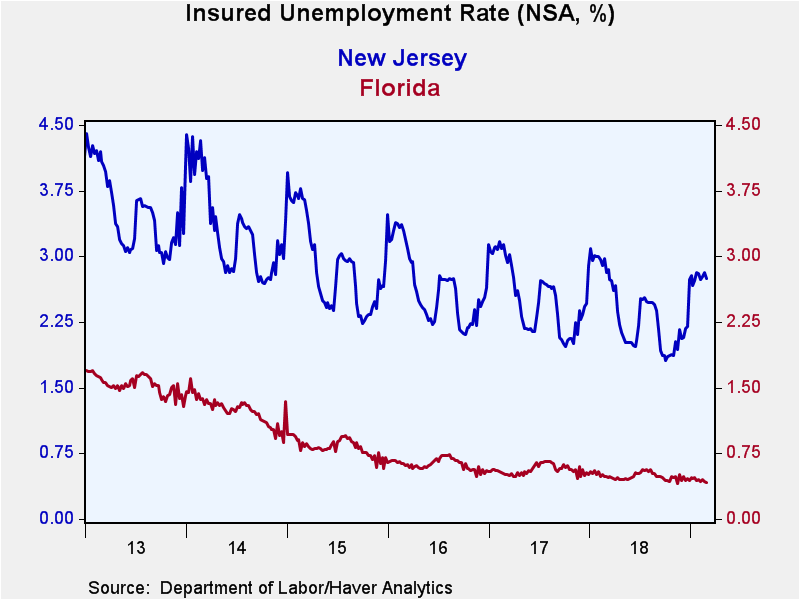 Global| Mar 21 2019
Global| Mar 21 2019U.S. Initial Unemployment Insurance Claims Decline
by:Sandy Batten
|in:Economy in Brief
Summary
Initial claims for unemployment insurance fell 9,000 in the week ended March 16 to 221,000 from 230,000 the week before, which was revised up slightly from an initially reported 229,000. The Action Economics Forecast Survey projected [...]
Initial claims for unemployment insurance fell 9,000 in the week ended March 16 to 221,000 from 230,000 the week before, which was revised up slightly from an initially reported 229,000. The Action Economics Forecast Survey projected 225,000 claims for this week. The four-week moving average of initial claims increased to 225,000 from 224,000 the previous week.
Continuing claims for unemployment insurance fell in the week ended March 9 to 1.750 million from 1.777 million the previous week (revised up slightly from 1.776 million. The four-week moving average in the week ended March 9 rose to 1.772 million from 1.766 million in the week before. Any way you look at these data, it is clear that unemployment insurance claims have been trending up slightly since last fall though they remain as historically very low levels.
This was the week in which the monthly employment survey is conducted. So, the figures for this week receive a little more market scrutiny than in other weeks for implications for the March employment report (released on April 5). Weekly initial claims in the week of February 16 (the week in which the February employment survey was conducted) were 4,000 lower than in the March 16 week but the four-week average was 11,000 higher in February relative to March. So it would seem that labor market conditions have changed little between these two survey weeks.
The insured unemployment rate—that is, continuing claims as a percentage of the measure of employment covered by the unemployment insurance programs—remained at 1.2% in the week of March 9.
In a separate program, one that acquired quite a bit of interest during the federal government shutdown, the number of federal government workers filing initial unemployment claims rose to 1,021 (not seasonally adjusted) in the week ended March 9, up from 814 in the prior week. During the shutdown, this figure had ballooned to more than 25,000. In the 52 weeks prior to the government shutdown in December 2018, this figure averaged 817 per week.
Insured unemployment rates vary widely by state. These state data are not seasonally adjusted and are reported with a two-week lag to the headline claims figure. In the week ending March 2, the lowest rates were in Florida (0.42%), North Carolina (0.48%), Georgia (0.59%), Tennessee (0.60%) and Virginia (0.62%). The highest rates were in Alaska (3.15%), New Jersey (2.75%), Montana (2.68%), Rhode Island (2.51%) and Connecticut (2.49%). Rates in other states with large populations include California (2.37%), Texas (0.94%), New York (1.72%), Pennsylvania (2.43%) and Illinois (2.19%).
Data on weekly unemployment claims going back to 1967 are contained in Haver's WEEKLY database and are summarized monthly in USECON. Data for individual states are REGIONW. The expectations figure is from the Action Economics Forecast Survey, carried in the AS1REPNA database.
| Unemployment Insurance (SA, 000s) | 03/16/19 | 03/09/19 | 03/02/19 | Y/Y % | 2018 | 2017 | 2016 |
|---|---|---|---|---|---|---|---|
| Initial Claims | 221 | 230 | 223 | -2.6 | 221 | 244 | 262 |
| Continuing Claims | -- | 1,750 | 1,777 | -4.7 | 1,766 | 1,967 | 2,135 |
| Insured Unemployment Rate (%) | -- | 1.2 | 1.2 |
1.3 |
1.2 | 1.4 | 1.6 |
Sandy Batten
AuthorMore in Author Profile »Sandy Batten has more than 30 years of experience analyzing industrial economies and financial markets and a wide range of experience across the financial services sector, government, and academia. Before joining Haver Analytics, Sandy was a Vice President and Senior Economist at Citibank; Senior Credit Market Analyst at CDC Investment Management, Managing Director at Bear Stearns, and Executive Director at JPMorgan. In 2008, Sandy was named the most accurate US forecaster by the National Association for Business Economics. He is a member of the New York Forecasters Club, NABE, and the American Economic Association. Prior to his time in the financial services sector, Sandy was a Research Officer at the Federal Reserve Bank of St. Louis, Senior Staff Economist on the President’s Council of Economic Advisors, Deputy Assistant Secretary for Economic Policy at the US Treasury, and Economist at the International Monetary Fund. Sandy has taught economics at St. Louis University, Denison University, and Muskingun College. He has published numerous peer-reviewed articles in a wide range of academic publications. He has a B.A. in economics from the University of Richmond and a M.A. and Ph.D. in economics from The Ohio State University.










